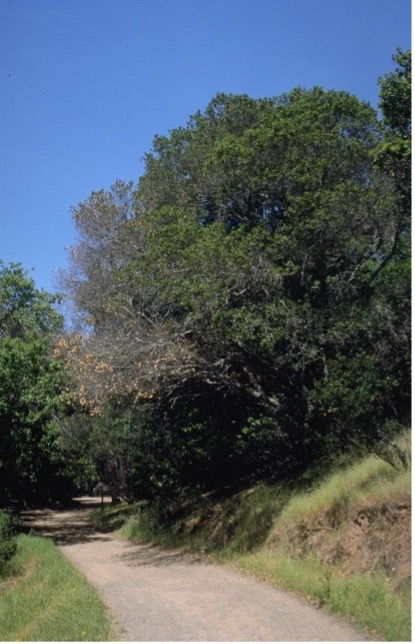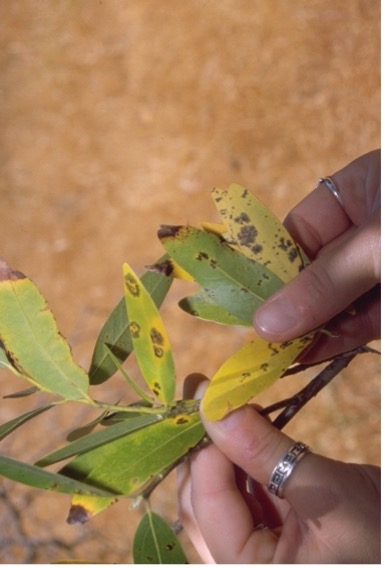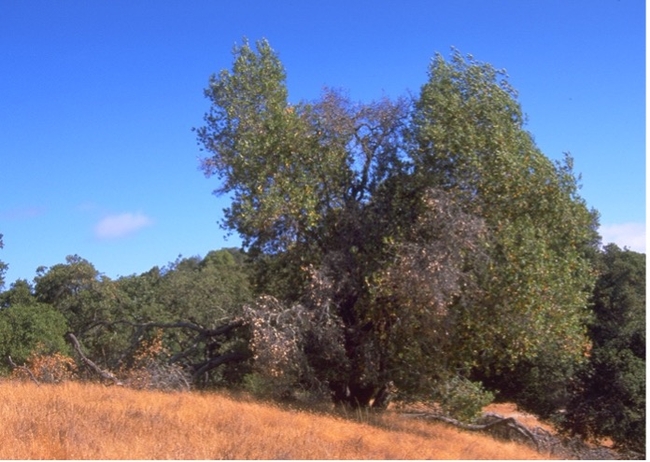- Author: Steven Swain

Sudden oak death (SOD) is a disease syndrome that has killed millions of native oak trees (Figure 1) along the west coast of the United States, from Big Sur in California up to Southern Oregon. The disease may involve several organisms, but its main driver is the fungus-like organism (known as water mold), Phytophthora ramorum. This plant pathogen is spread in the springtime by windy rainstorms. It infects the bark of oak trees, frequently creating bleeding trunk cankers that interfere with water uptake and sugar transport.
Death of SOD-infected trees can be accelerated by attacks from bark and ambrosia beetles. In the absence of beetle attacks, infected oaks may take years to die.
Many common disorders (other than P. ramorum infections) can cause damage that resembles SOD, so laboratory testing is needed to confirm the diagnosis.
Sudden Oak Death Host Range
Sudden oak death isn't always sudden, nor does it infect just oaks. The potential host list of P. ramorum includes hundreds of plant species, many of which are natives of California's woodlands and forests. In most of these host species, the pathogen simply causes small necrotic spots on the leaves (Figure 2). In a few instances, notably in certain susceptible Rhododendron cultivars, the disease may progress from the leaves down into the stem and kill the plant.
Phytophthora ramorum has evolved as a foliar pathogen, primarily spreading from the leaves of infected hosts such as bay laurel (Umbellularia californica), tanoak (Notholithocarpus densiflorus), and rhododendrons. Therefore, it does not spread easily to other plants from oak trunk cankers. Thus, when oaks become infected, they are referred to as terminal hosts. Tanoak acts as both a foliar host, spreading spores from its leaves in wet and windy weather conditions, and a terminal host, developing cankers that are almost always lethal to the infected plant (Figure 3). Perhaps because infected tanoak leaves rain spores onto their own trunks, their SOD survival rates are among the lowest of all trees that may become afflicted by the disease in North America.
Despite its fearsome reputation, SOD doesn't always kill infected oaks. Valley oak (Quercus lobata), blue oak (Q. douglasii), and Oregon white oak (Q. garryana) are not known to develop cankers in nature, while coast live oak (Q. agrifolia), black oak (Q. kelloggii), Shreve oak (Q. parvula var. shrevei), and interior live oak (Q. wislizeni) are considered susceptible. Recent studies have demonstrated that there may be considerable variance in some coast live oaks, with measured resistance varying from about 16-40%. Many of these resistant or tolerant trees do become infected but are able to defeat the pathogen before trunk cankers enlarge to life-threatening sizes. Casual observations suggest that resistance levels seen in coast live oaks are likely similar to those in Shreve oak and black oak populations. Because interior live oak trees grow in comparatively hotter, dryer, environments than the other susceptible oaks, they almost never become infected, so resistance levels have not been studied. Tree age seems to play a role too. Oak trees under four inches in trunk diameter at chest height are not typically susceptible to infection by P. ramorum.
Treatment Approaches
Many different treatment approaches have been trialed, a few of which have shown promise.
Prevention
Potassium phosphite compounds (AgriFos, Reliant, Garden Phos, etc.) work best as preventive treatments. Most of the efficacy achieved by these compounds appears to be the result of stimulating the trees' natural defensive systems, although individual oaks vary widely in their immune responses. Thus, the application of potassium phosphite compounds is a bit of a gamble as to whether it will actually help an individual tree. Trees that are already showing symptoms of infection when treated have a significantly lower survival probability than trees that appear healthy during treatment.
There are two different recommended application methods for potassium phosphites—surface sprays made directly to the bark (using a surfactant such as Pentrabark) and trunk injections. Some applicators have claimed increased efficacy from the trunk injections, albeit at the cost of potential damage to the tree from wounding. Others have claimed equivalent efficacy with repeated bark sprays, when carefully timed. Application of calcium to the root zones of oaks treated with potassium phosphite has been shown to further improve resistance rates.
Potassium phosphite treatments should be made in the spring and fall, regardless of the application method used. This is because the uptake of potassium phosphite by the tree is dependent on high transpiration rates. High transpiration rates in turn depend on both adequate available soil moisture, and warm and sunny weather, preferably with a light breeze.
Another preventive treatment option that has proven to be effective is removal of foliar hosts that are near highly valued oak trees (Figure 4). Removing bay laurels that have foliage within about 30 feet of an oak trunk decreases the chances of that oak becoming infected. Removal is especially effective for small, understory foliar hosts, such as young bay laurels, poison oak, and rhododendron. This is not a recommendation for the wholesale removal of bay laurel trees, which are important parts of the California forest ecosystem and should be retained where appropriate. This management approach should only be adopted after careful consideration of the ecological function of the forest or woodland as a whole.
Management of Active Infections
Bark scribing, or cutting away the outer portion of infected bark to let the infection site dry out, was previously touted as an effective treatment for infected oaks. However, rigorous testing has since shown that it does not significantly increase the odds of an oak surviving. Similarly, the application of whitewash to tree trunks has not been shown to make measurable improvements to survival of treated oaks as compared to no treatment at all.
Mefanoxam (Subdue Maxx, Stergo MX, etc.) is a fungicide with a proven record of suppressing Phytophthora activity. It has been used to successfully treat infected plants, keeping them alive as long as treatment continues, typically over the span of a year or two. However, in most cases, once treatment stops, Phytophthora begins growing again within several months, and the infected plants will eventually succumb to the disease. While mefanoxam fungicides may be effectively used in certain limited situations, they should not be considered effective curative treatments. Resistance to this active ingredient has developed repeatedly, rendering it unacceptable for long-term use.
In summary, no silver bullet exists for preventing SOD, and there are no effective tools that will reliably save a tree that is already showing symptoms of infection. This does not mean that any oak that exhibits SOD trunk cankers or bleeding symptoms will die. Bleeding from the bark is a normal response to substantial damage, whether from a pest, pathogen, or, sometimes, even mechanical damage. Even if bleeding is the result of infection by P. ramorum, symptomatic trees have recovered with no intervention, usually in association with a few dry years. The most effective tools for managing SOD are preventive, in nature. For more information and best management practices, please see the California Oak Mortality Task Force website at: https://www.suddenoakdeath.org.






Thanks for your comment. This article was focused more on SOD in natural areas/wildlands rather than the home landscape, which is why some of these cultural control practices are not mentioned. Overwatering and poor drainage are still important factors for Phytophthora development.
It's important to understand the differences between different types of Phytophthora. The majority of Phytophthora species, such as P. cinnamomi and P. lateralus, are soil borne. Control of these diseases almost always requires careful consideration of irrigation practices to control their reproduction and spread, especially in landscape and nursery settings. Drainage, perhaps unsurprisingly, is also a critical consideration, and must be managed as well.
However, some Phytopthora species, such as P. infestans (a major contributor to the Irish potato famine), and P. ramorum (the primary factor in sudden oak death and the topic of the article in question) are aerial Phytopthoras. Since these diseases don't frequently infect or spread in the soil, irrigation management and drainage considerations are largely moot, at least in landscape settings, and that's why this article doesn't explore those topics.
In nursery settings, irrigation management IS an issue, as nurseries can ship the disease in infected plants, and the disease is federally quarantined. This means nurseries have to be free of P. ramorum to ship plants. Because P. ramorum can spread from one plant to another in the potting soil, even if it doesn't infect the plant (though some Rhodies can be infected this way), the pathogen has to be contained.
Again, this article was aimed at the landscape and wildland urban interface audiences, not the nursery trade, so that information was not included. However, if you'd like to explore further, there's plenty of information available at www.suddenoakdeath.org .